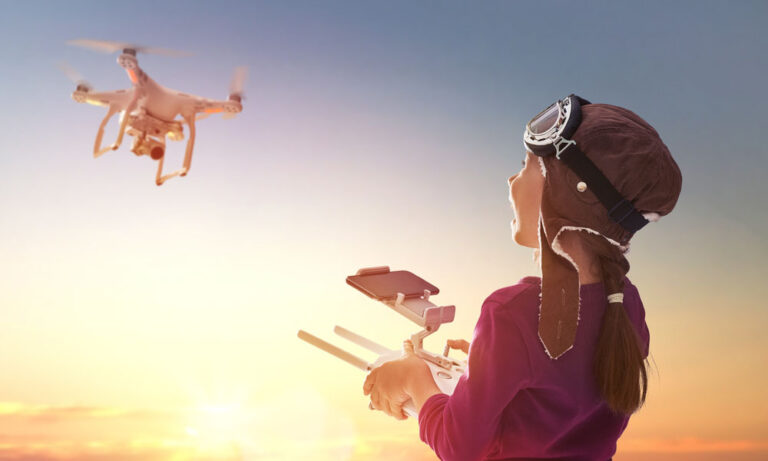Now, I’ll do my best to describe you a few of the best drones for kids which are most acceptable for kids of all ages. That is the reason why we’ve split this child friendly drones listing into a number of different age groups so that you can better comprehend the versions readily available on the marketplace.
Along with this, we’ll also offer you a few safety tips in addition to an overall introduction you need to explain to your little ones prior to their initial flying semester. As I’ll mention a few times moving forward — drones aren’t a toy! With that being said, let us have a better look in drones for kids.
List of 9 Best Drones For Children
1. Holy Stone HS170 Predator Mini RC Helicopter Drone 2.4Ghz 6-Axis Gyro 4 Channels Quadcopter Good Choice for Drone Training
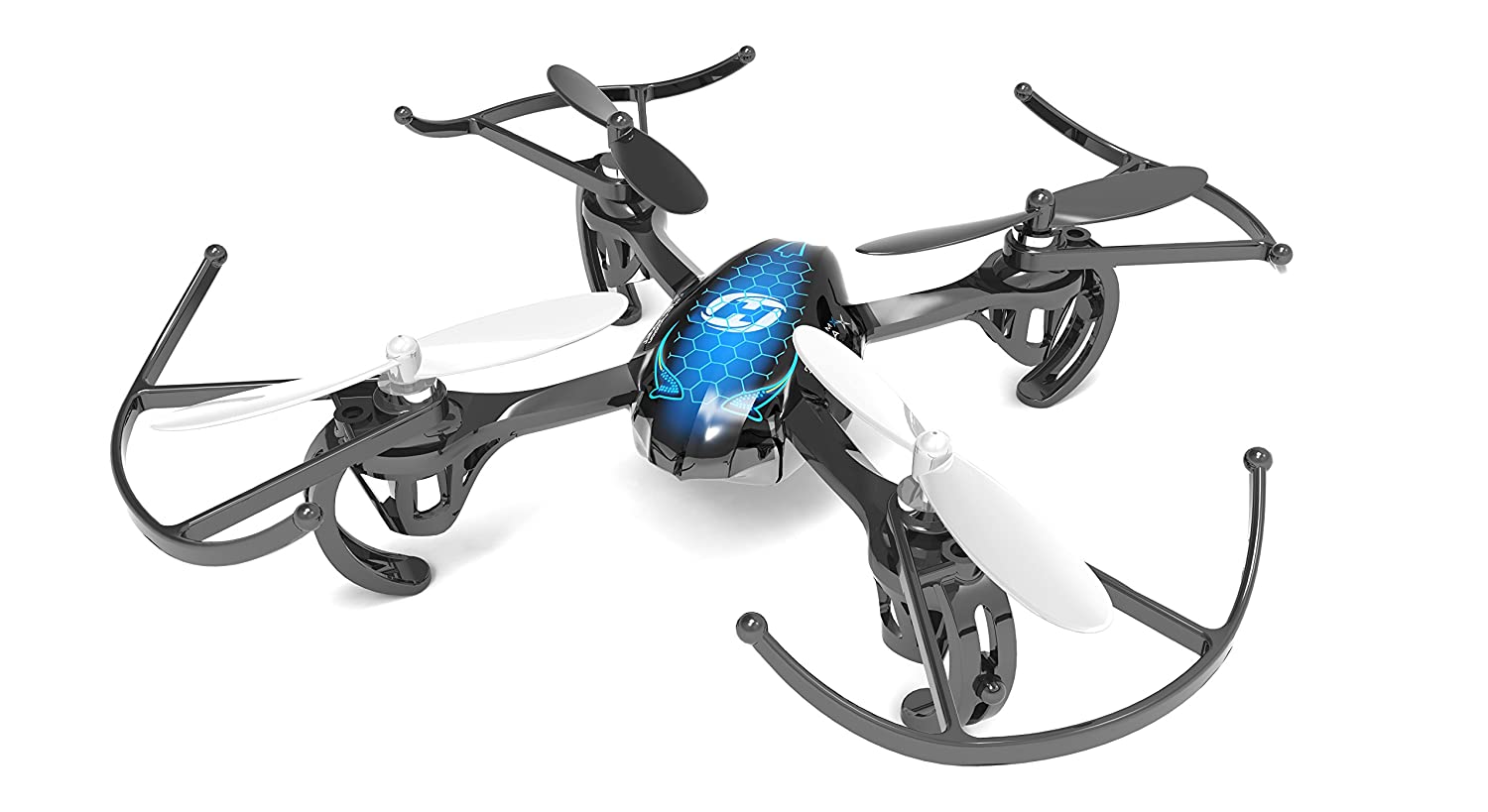
Headless Mode brings considerably more assurance for those novices and young children, below which regardless of what way the aircraft is facing, forward stick is forward, and back stick is backward.
6-Axis Gyro Technology allows the drone to reverse and function with an easy push of this button. Hold down the perfect path stick to do a cool roll in any way.
3 Different Speed Techniques for beginners to more advanced pilots. Super rapid in the maximum speed for a micro quad.
The Colorful LED lights make it straightforward to spot the front and back in order to create the quad an excellent night flyer.
2. Altair #AA108 Camera Drone Great for Kids & Beginners, RC Quadcopter w/ 720p HD FPV Camera VR, Headless Mode, Altitude Hold, 3 Skill Modes, Easy Indoor Drone, 2 Batteries
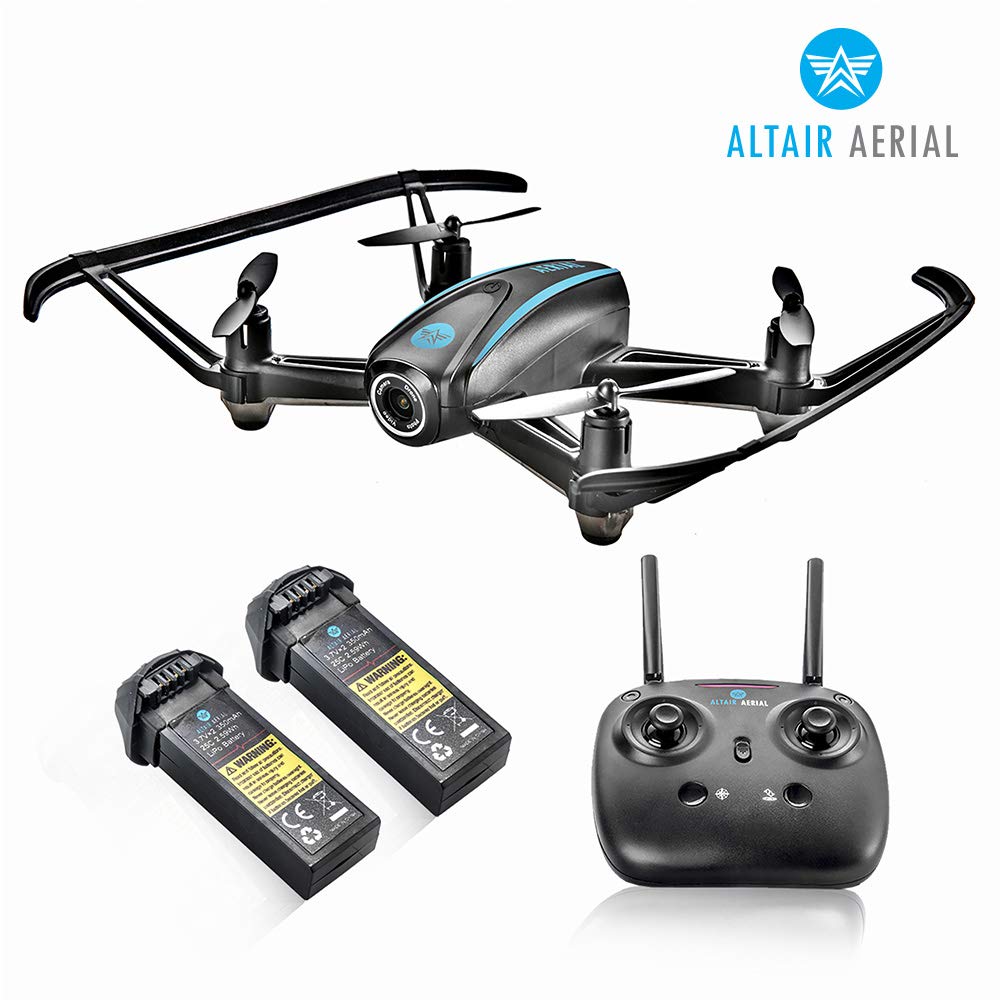
PREMIUM 720P CAMERA DRONE W REALTIME VIDEO: The Aerial AA108 has a 120 Degree Wide-Angle 720P HD camera which takes amazing photos and videos from birds eye view directly from your phone.
EASY TO FLY – The Altair Quadcopter can be readily piloted & includes Headless Mode, Altitude Hold & 1-button takeoff & landing. This is a wonderful drone with camera for children, beginners and professional pilots, simple to fly indoors also.
STABLE FLIGHT & DURABLE CONSTRUCTION for Long Lasting Fun! The Altair also offers Custom Route Modes, Utilize your own smartphone to draw a customized flight line onto your mobile screen along with the drone will soar depending on your flight lineup.
LONG RANGE & FLIGHT TIME – 100 Meters / Up to 10 Minutes, 720p Actual Time FPV (First Person View) Great Drone For Beginners. Additionally Includes Advanced Remote Control Technology, NO SMARTPHONE REQUIRED, Out of scope alert, emergency landing feature, and very low battery alert is going to continue to keep the pilot along with your Altair drone secure.
3. Remote Control Drone with Camera – U818A Discovery HD Camera Drone Long Range Flying Drones for Adults or Kids w/ LEDs, Micro SD, Extra Drone Battery
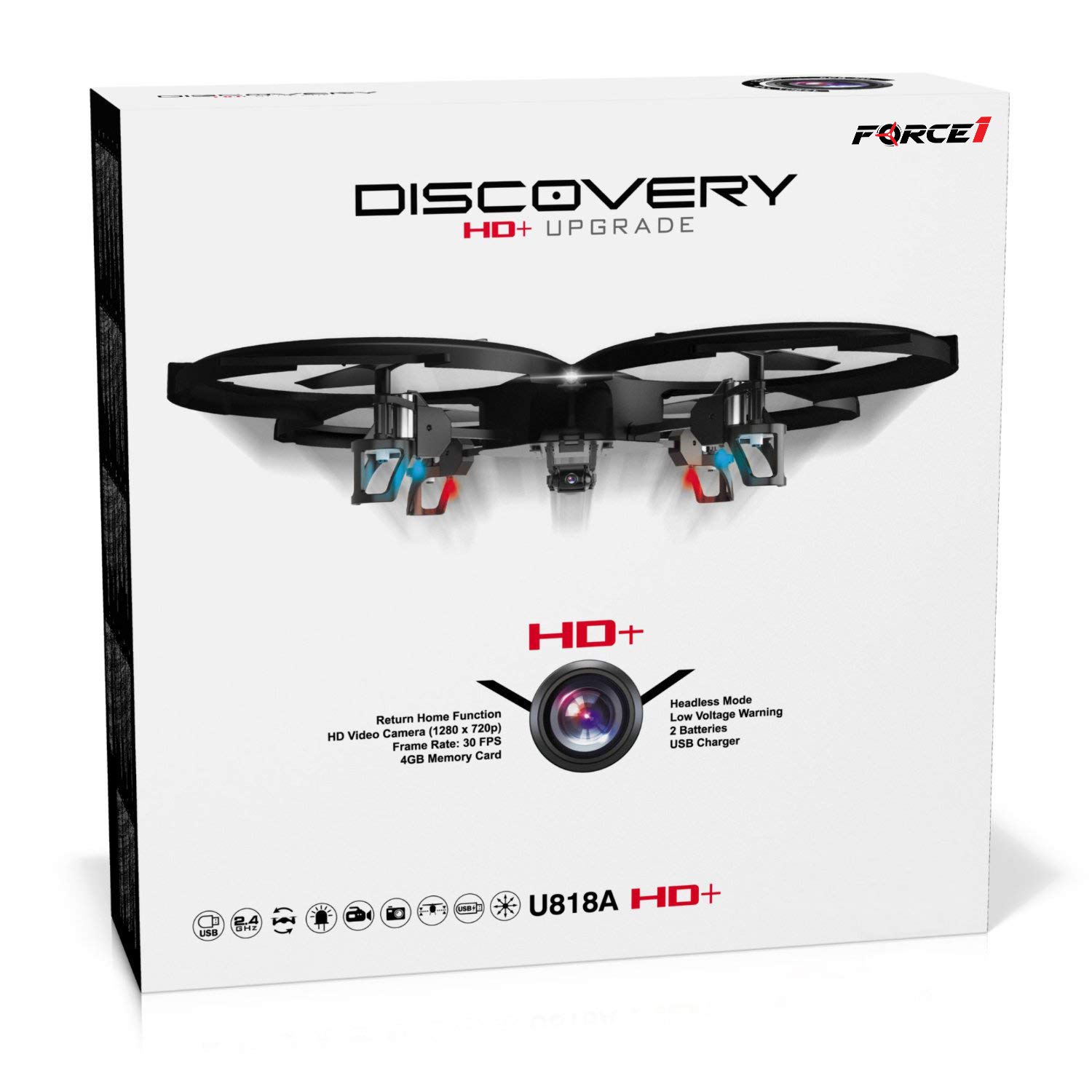
MAKE MEMORIES using 720P HD VIDEO DRONE for KIDS and ADULTS: Among our greatest drones with camera for both adults and children; Contained 4GB Micro SD reader and card allow this drone camera capture cool aerial photographs and save RC drone video
SUPER STABLE FLYING DRONE: All these drones for novices make excellent gifts for their; Headless Mode creates these very great beginner drones for first-time stocks by providing orientation management
ULTIMATE SUMMER TOYS WITH RETURN HOME MODE: The actual reason why these quadcopter camera drones are Amazing toys for youngsters Is in the Return Home (RTH) work; even a low battery warning tells you when it is low on juice
ENJOY LONG FLIGHT TIMES and RC QUADCOPTER DRONE EXTRAS: Drones for novices barely ever come completely loaded w/ additional drone batteries along with a power lender, but this camera drone is piled; Fly your remote control drone toys for up to 18 minutes per charge
4. Air Hogs Star Wars Remote Control Millennium Falcon Quad
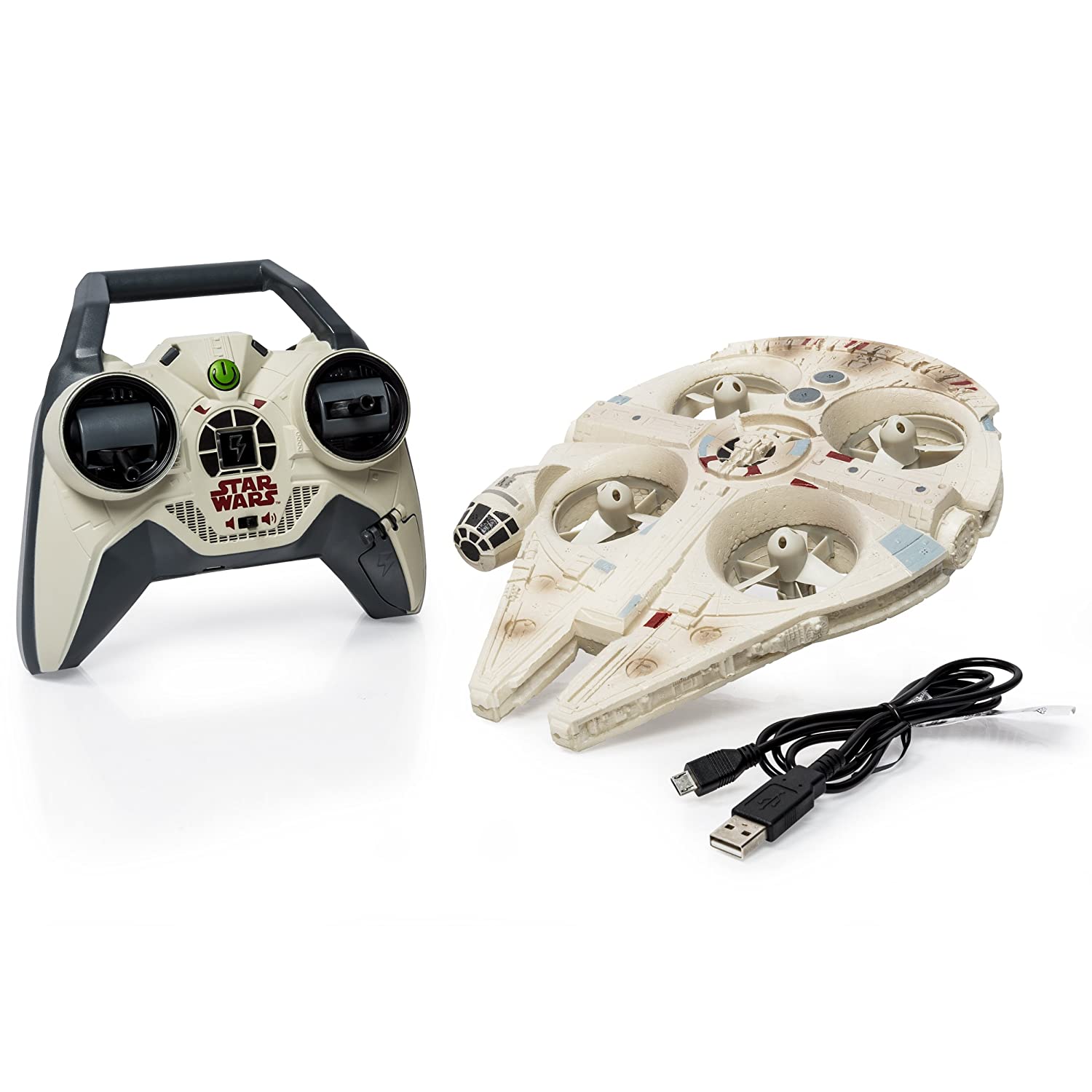
Only Air Hogs provides you the best Star Wars flying adventure. You can now fly the many iconic boats in the Star Wars world, The Millennium Falcon, directly in your own backyard!
The supreme Millennium Falcon takes flight with all the ability of four quad rotors hidden in the ducts of the ship for agile, space-like airport! Its onboard Gyro-stabilization offers smooth and stable flight for the ultimate flying experience.
The instinctive Remote Control is simple to use and also makes flying the Millennium Falcon easy. It is 2.4GHz communication allows for a massive flying array. Navigate the asteroid areas of your backyard from around 200 feet off with exceptional control.
Authentic lights and noises in the Star Wars world bring the Millennium Falcon into lifetime as possible fly. Listen to the Falcon’s search engine sounds as if you re-create your favourite assignment. Even the LED thrusters illuminate as you fly to deep space like in the film!
The Millennium Falcon is made of impact resistant foam which makes it resilient to minor crashes. The foam center ducts offer the rotors additional security when flying indoors as well as outside. Fly the many iconic ship in the Star Wars world right in your backyard, The Millennium Falcon just from Air Hogs.
5. DROCON Drone for Beginners, WIFI FPV Drone With 720P 120°Wide-Angle Camera
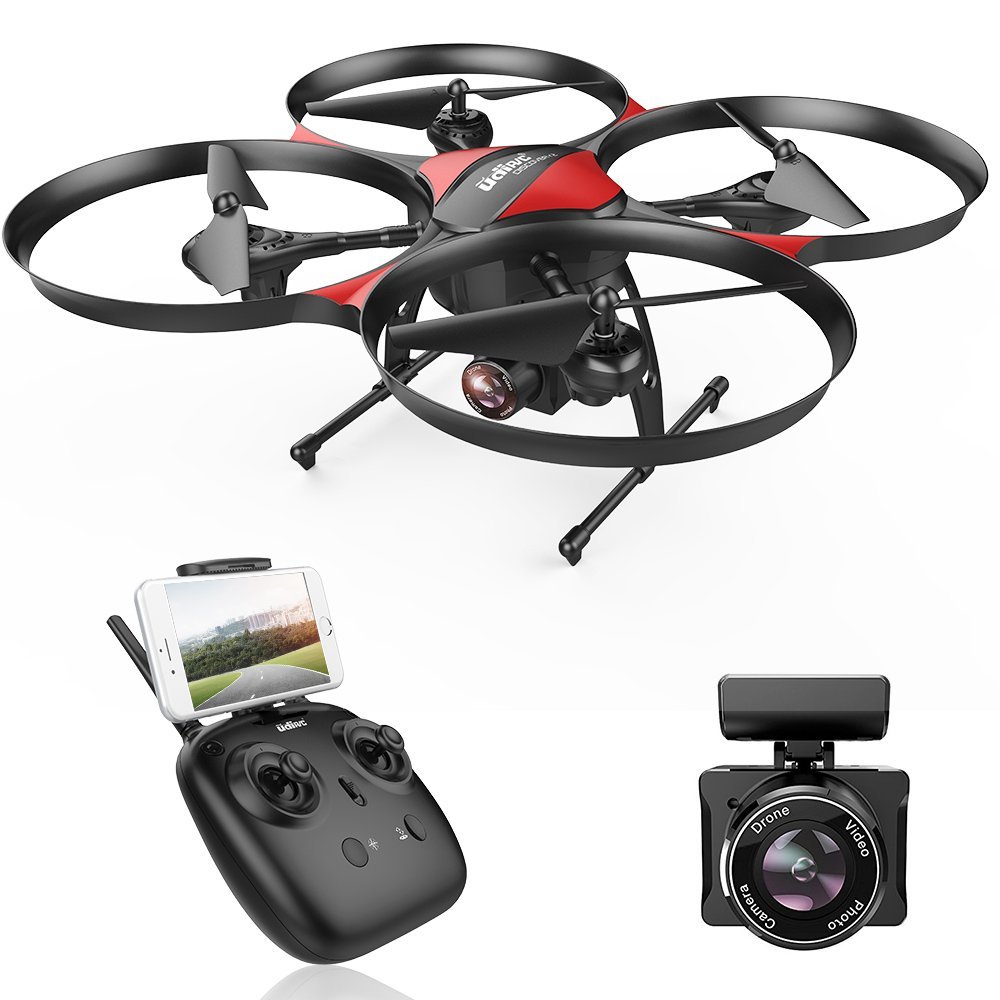
UPGRADED CAMERA: Wide Angle Lens: FOV 120 Degree; Video Recording Mode: HD1280 x 720p; Max Video Bitrate: 30 Mbps; Damping Material: Rubber; Upgraded Feature: OPTICAL ANTI-SHAKE, Better for Permanent Photography or Much Selfie along with VR View Requirement.
WI-FI FPV REAL-TIME TRANSMISSION: Together with the WI-FI FPV feature, it is possible to see just what your camera sees using a live video onto your mobile device after installing the update flying see program. Further more, there are more pleasure with functions such as Custom Flight Route, Gravity Control and 3D VR Mode. | Live Video Quality: 720P in 20fps.
ALTITUDE HOLD MODE: Easy Flight Mode Drone For Beginners or Kids: Altitude grip manner means flying the drone in a specified elevation. Under this manner, you can produce the drone flying at the default height and hover.
DRONE for BEGINNERS or KIDS: Apart from altitude hold mode, the U818PLUS version was created with more roles for beginners or kids: HEADLESS MODE, SPEED SWITCH, ONE-KEY TAKE OFF / LANDING, EMERGENCY STOP, LOW POWER along with OUT-OF-RANGE ALARM.
6. Holy Stone F181C RC Quadcopter Drone with HD Camera RTF 4 Channel 2.4GHz 6-Gyro with Altitude Hold Function,Headless Mode and One Key Return Home
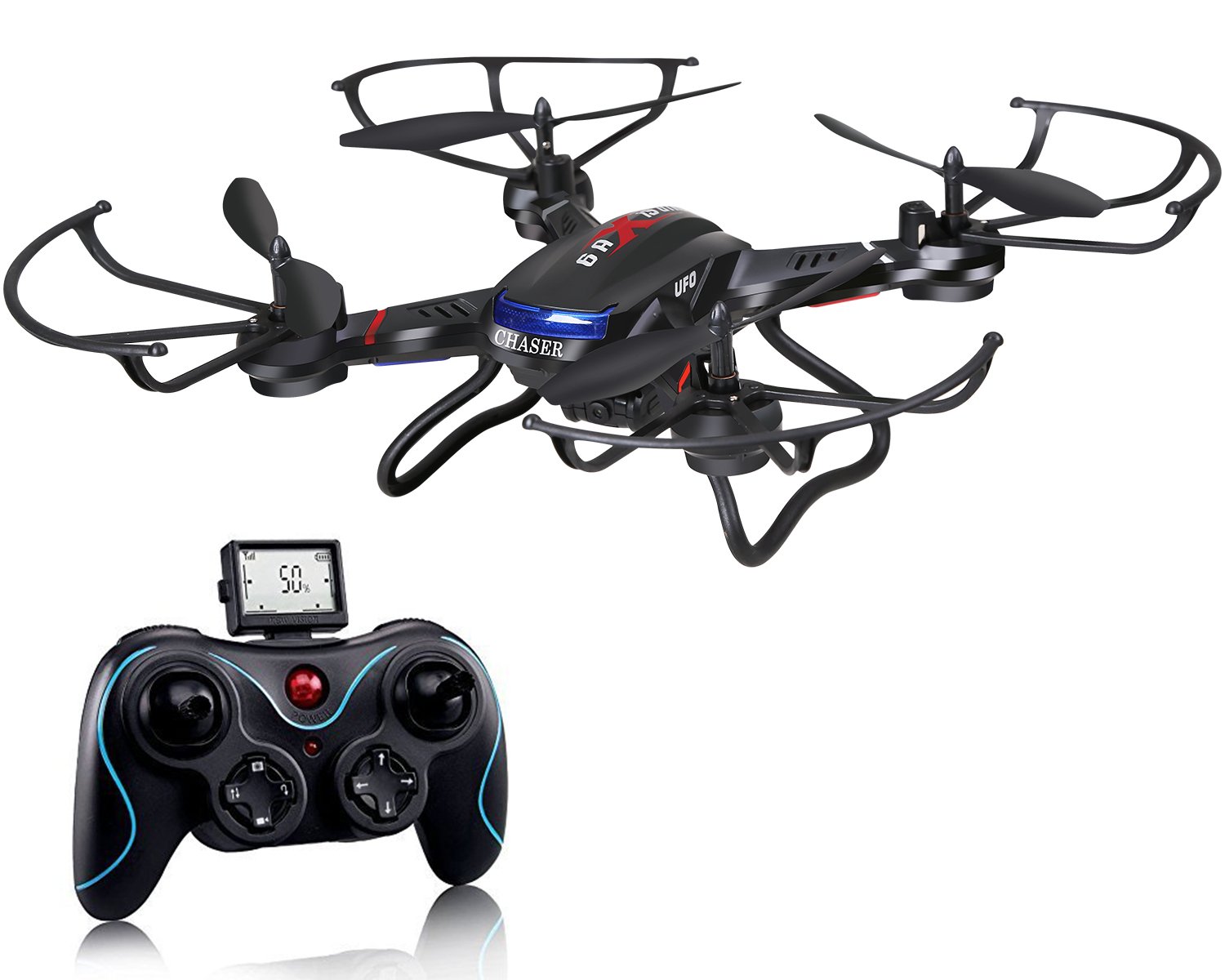
Equipped with One Key Return & Headless Security System to Aid beginners and help stop losing the drone
Altitude Hold Function: Powerful air pressure altitude hold function enables the drone to put in it’s present height after discharging the throttle stick. Easy for one to shoot at quality videos or images.
1 Essential 360° 4-Ways Twist (left,right,forward,backward), Continuous Roll To Get Perfect Action And Beautiful Performance
Come With Two Cells (BONUS BATTERY) For Longer traveling Period.
Range: Around 50-100 Meters. Battery Flight Time: About 7-9 Minutes. Charging Time: About 80 Minutes. No more FPV (First Person View).
7. Redpawz H36 Mini Drone 2.4G 6 Axis Gyro Headless Mode, 360° Flips, Remote Control One Key Return RC Quadcopter, Best Drone for Kids & Beginners
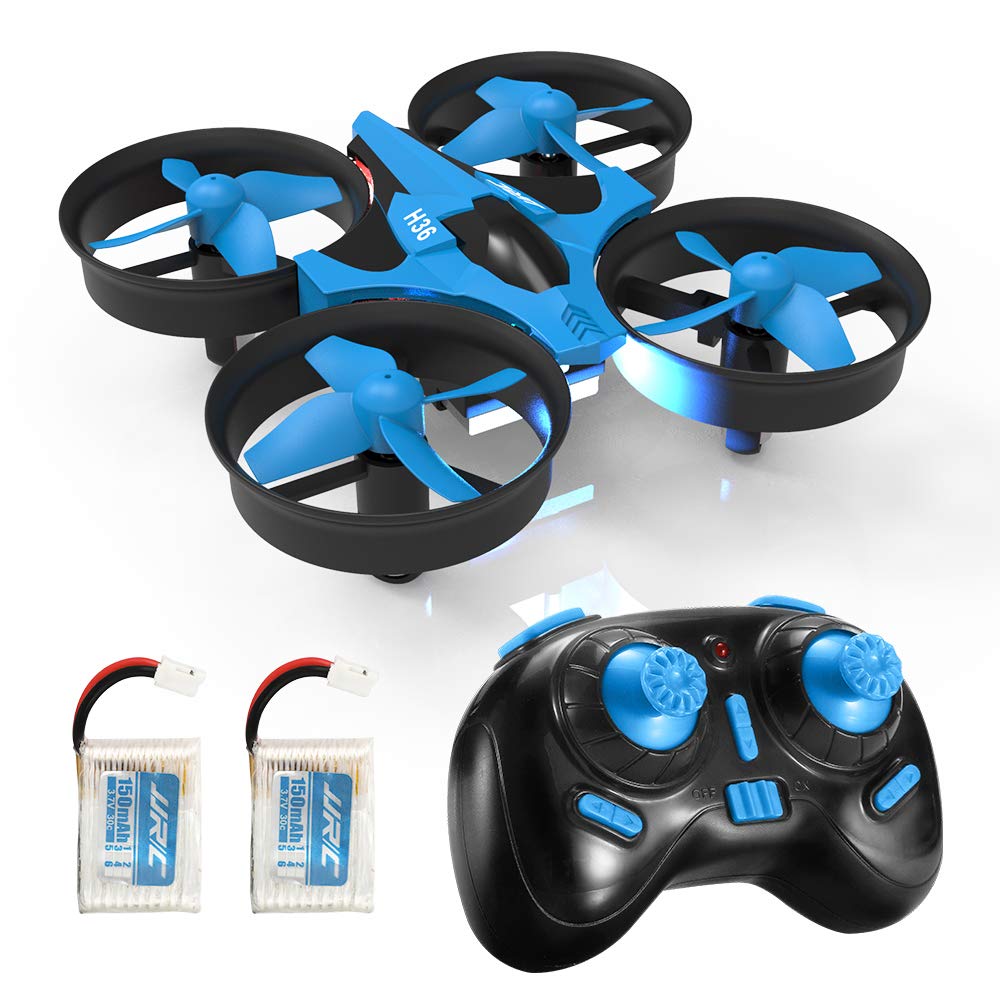
Headless mode: once activated, the pilot can fly the drone into any place with no need to be concerned about which direction The drone is currently confronting. Strong stability and simplicity of management.
1 key return: that the quadcopter is outfitted with a single key yield, making the drone much easier to better and fly to command for almost any amount of gamers.
3D roster: simply press the button transmitter, and you receive 360-degrees flip, up/ down/ left turn/ right turn/ forward/ back/ left side fly/ right side fly.
Led lights: the uniquely constructed LED lights have been fitted for nighttime flight choices, leaving a gorgeous landscape at the night skies.
8. EWONDERWORLD Kid Drone for Beginners Easy to Fly Stunt Drone Quadcopter
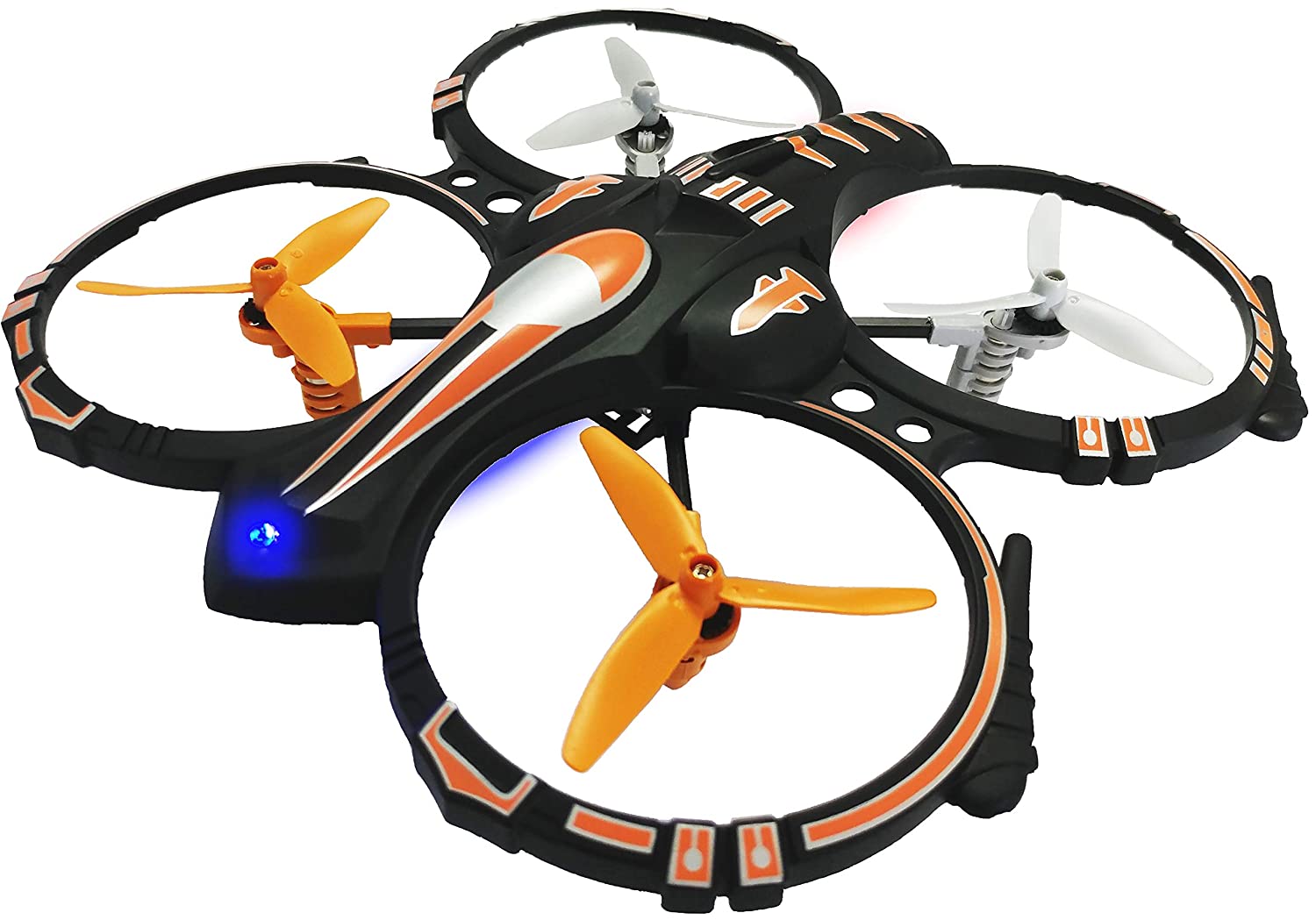
PACKAGE INCLUDES: Stunt Drone, remote control, 1 Li-Polymer rechargeable battery, USB charger, replacement generators, and exercise landing pad
DURABLE DESIGN: Using reinforced screws and a lightweight framework, this toy drone may manage crashes rather than lose push in any of those 3 blade propellers
EASY TO FLY: Using easy controls and effortless maneuvering this quadcopter drone also makes it the perfect drone for children and adults. With a press of a button that the drone can perform 360 flips in flight
HIGH QUALITY TECHNOLOGY: The 6-axis gyroscope will correct the rc quadcopter to get a more secure and smoother trip. The controller utilizes 2.4 GHz frequency to get faster and enhanced control with little battery consumption
USB CONNECTIVITY: Recharge the rc drone battery with the easy advantage of the USB charger and control it everywhere a USB outlet is available
9. Cheerwing Syma X5SW-V3 WiFi FPV Drone 2.4Ghz 4CH 6-Axis Gyro RC Quadcopter Drone with Camera
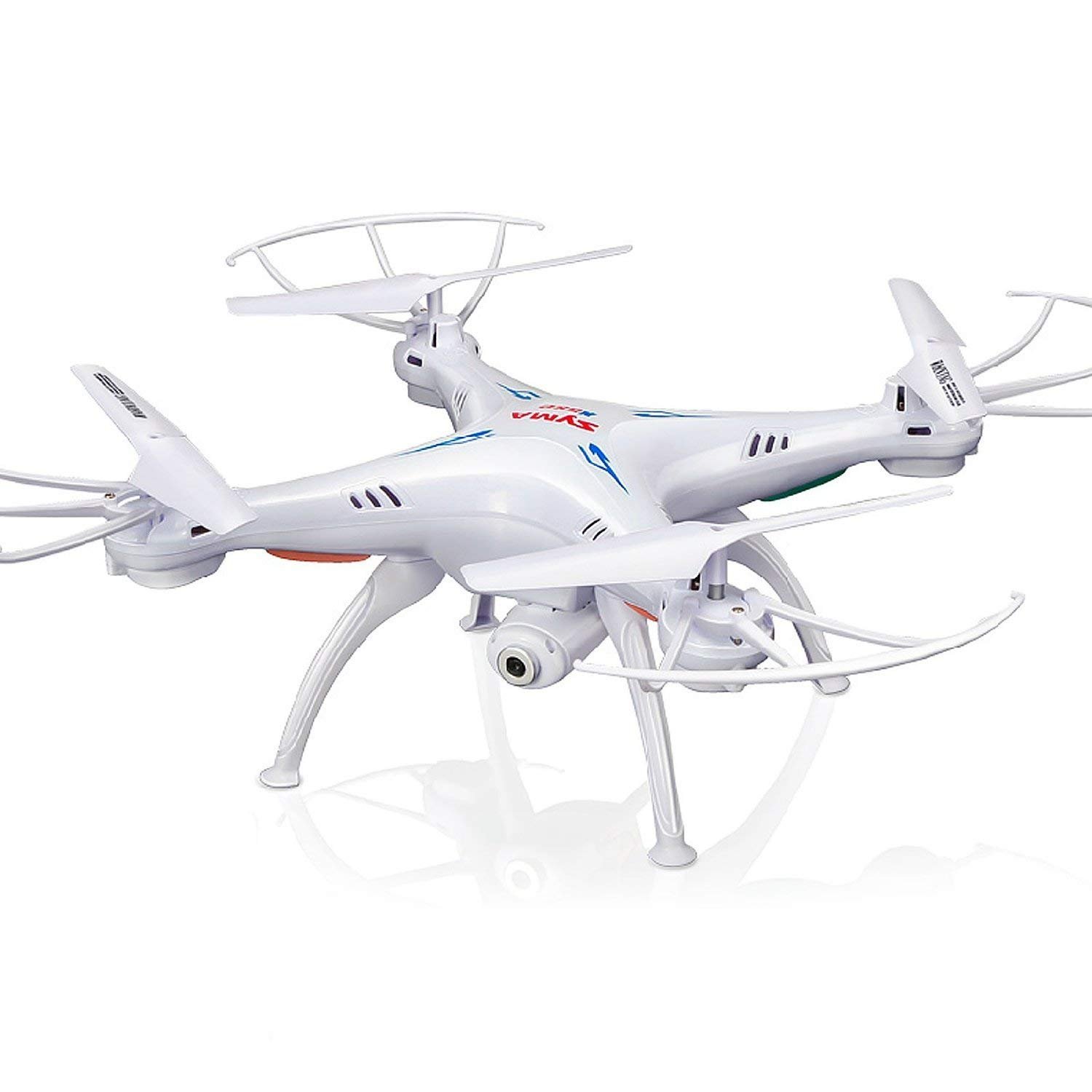
Headless/IOC function. Typically, the forwards management of a flying multi-rotor will be just like the nose management. By utilizing headless/IOC, the forwards direction doesn’t have anything to do with nose management. This reduces the steepness of the learning curve and allows the pilot to relish flight whilst gradually learning every particular orientation of their quadcopter.
Equipped with the newest 6-Axis flight management systems, 3D lock, even greater scheduled flight, working over the force!
Equipped using HD camera to shoot videos and photos while flying! Bring a fresh outlook to your photographs and videos in the air.
Wi-fi FPV permits you to see pictures & Video while flying it supports almost any IOS and Android phones. The Mobile Phone holder keeps your phone protected All of the Moment
1 key 360° roll, constant roll for ideal action and amazing performance.
What You Need To Know Before Buy A Drone
Different Types of Drones/Quadcopters
First thing’s first, the different layouts of drone and the differences between them:
- Tricopter – these are typically laid out in a “Y” shape, with two rotors at the front and a third at the back, on a tilting arm. This third rotor helps control rotation and pitch. Tricopters allow a good camera view of what’s ahead, because the arms can be spread wider. There are less motors and ESCs to buy, so tricopters are cheaper overall, despite having a servo.
- Quadcopter – the most popular of the options we’re looking at, quadcopters use four rotors and the most popular configuration is the “X”, which puts two rotors at the front and two at the back. You can also configure quadcopters in a “plus”, these layouts essentially rotate the layout by 45 degrees, placing a rotor at each of front, back, left and right. “X” is the most popular layout as it provides reasonably clear forward flight video, whereas on a plus layout, you need to work a lot harder not to have a drone arm in your video. The benefit of the plus layout is that you have a definite front arm, making the quad easier to fly by line of sight.
- Hexacopter/Octocopter – you guessed it, these two have six/eight rotors! As each rotor has a limited maximum force it can exert, by adding more rotors you are able to produce more thrust. More thrust equals a higher payload capacity, whilst still maintaining maneuverability. If you look at professional aerial videography drones, you will find that they are almost always hex or octocopters and this is because the cameras used are heavy and simply wouldn’t be lifted by something with fewer rotors. The additional advantage of using a hex or octocopter is that with more than four rotors you have redundancy. Should a motor fail or a prop break off when bumping into a tree, you have enough rotors still going to safely bring the drone back. This is incredibly important when dealing with expensive camera equipment.
Drone Frame Guide
This is fundamental and is primarily determined by what you will be using the drone for. The frame will set the type of layout and number of rotors your drone has, like we discussed above. The frame is what everything else is mounted to, so having something strong but lightweight is important regardless of what you will be doing with your drone.
Most ready to fly toy grade drones will have a plastic frame and shell. For gentle knocks these are great and will hold up well simply because the whole drone is so light. They are cheap, lightweight and reasonably strong, but don’t expect them to last forever. The majority of ready to fly (RTF) drones, including more expensive camera drones with GPS systems utilise a plastic frame, so don’t let this put you off.
The next step up from plastic is glass fibre, which is a reasonably lightweight, stiff material typically found in budget drones. We personally do not recommend glass fibre frames, as the likelihood of breaking in a hard crash is too high for us. We recommend using a full carbon fibre frame instead, as these are much more hard wearing and can take quite a crash without a problem. They are a little bit more expensive, but then you do get what you pay for and will same money in the long run from not replacing broken parts. Carbon fibre is the preferred material when looking towards the higher end.
If you are building from scratch, then you have a lot of different frames to consider and probably already have an idea of the type of frame you like. The main thing worth considering here is how easy the frame will be to repair, if it can be repaired at all. Some frames have a solid single piece bottom plate, which provides great stiffness and strength, but the downside is that if any part of it breaks, you will be replacing the whole thing and effectively rebuilding your drone in the process. The alternative is to select a modular frame, as these typically have replaceable arms, making repairing crash damage much easier. The second thing to consider when building from scratch is the amount of room you will need in order to fit all of your components into the frame. Don’t get caught out and check out other people’s builds before committing to something that could leave you with bits hanging outside the protective frame.
Drone Flight controller (FC)
Not relevant for a lot of drones, which will have a flight controller built into the main board, but if you are looking at building your own drone, then selecting one with the right level of functionality is important. Grabbing an acro FC because it is a lot cheaper that one with GPS is pointless if you are wanting to build a stable camera platform. Equally, buying an expensive FC for a racing drone is simply not necessary. There are flight controllers designed for particular applications and there are more and more being introduced, with features and specifications improving very rapidly. We won’t go into detail about specific flight controllers today, but when selecting one think about what you will be using the drone for (do you really need that GPS module on a racing drone?) and what features are useful. If you are into racing, you will want something with a fast processor, but minimal other bells and whistles. If it’s a stable camera platform you are aiming for, then features like level and GPS hold are key. Keep reading to find out more about these modes and why they are important.
Flight Modes
This will be down to your drone or flight controller, but generally you will encounter some of the following basic modes:
- Angle – this is an auto-leveling mode that has a restriction on how far you can tilt the drone in any direction. This is ideal for beginners, who should be taking things slow at first. The auto-leveling means that once you stop pushing your pitch/roll stick and centre it, the quad will go back to level.
- Expert – typically only found on toy grade drones, this mode will allow you to tilt further, going faster. It may also give you more throttle to make use of, depending on your model. The drone will go back to level when you release the pitch/roll stick.
- Headless – another great mode for beginners or those who want to focus more on the video being captured than worrying about orientation of the drone. In headless mode the drone will move as though it has no front and instead fly in the direction you push your stick, regardless of which way the drone is facing. This mode is typically encountered on toy grade drones and is not common to see on the more expensive models.
- Acro – in this mode you are the only thing keeping the drone in the sky! Push your stick forward and the drone will tilt accordingly, but move back to centre and the drone will hold its angle until you adjust it by pulling back on the stick. You can think of this as much more like controlling a plane because of the need to level out. Acro is the preferred mode for pilots pulling off stunts as it provides the greatest level of control and removes any interference from the FC.
- Horizon – a halfway house between angle and acro, in horizon mode you can tilt the drone as far as you like, even rolling over fully, but once the sticks are centred the drone will go back to level.
- Level hold – utilises a barometer or optical sensors to maintain a constant height above the ground, allowing you to focus more on the orientation and direction of the drone. Ideal for beginners who are more prone to crashing, but also camera operators who want one less thing to think about.
- GPS hold – the drone will hover over a spot on the ground, maintaining position in wind by tilting into it, allowing you to focus only on orientation and height. This is ideal if you are capturing video from a particular location, but should be used when you have a gimball, to stabilise and level the video. GPS hold and level hold can be combined, allowing you to control just the rotation/yaw or take over the camera gimball. This combination effectively gives you a stable fixed camera platform in the sky.
- Return to home – when all else fails or you are running low on battery, having a return to home feature will help you get your drone back, avoiding lots of searching for a crash site!
- Depending on the reason why you want to buy a drone you may want to search for some of these features – be it racing, filming, or leisure.
Radio Transmitters
Most toy grade drones and consumer grade camera drones will come with a transmitter and so you are fairly limited on options. If you are building your own drone, then you will have to select one that fits your needs. Transmitters (even toy grade) typically come in one of two main “modes”, being Mode 1 or Mode 2. Although Mode 3 and Mode 4 exist, they are very uncommon and so we will not be covering them here. Mode 1 has the throttle stick on the right and the elevator or pitch on the left, in Mode 2 this is reversed. The rudder/yaw is on the left and the aileron/roll on the right in both modes 1 and 2. As Mode 2 is the most popular and is what the majority of pilots fly (including ourselves), this is what we recommend to anyone entering the hobby for the first time.
Batteries
We have a much more complete article covering batteries, but the basic terminology you need to know is detailed below:
- Capacity – this is normally provided in milliamp hours (mAh).
- “C” rating – this is used to calculate the discharge rate for the battery. By multiplying the C rating with the capacity, you will get the instantaneous Amps that your battery can safely provide.
- Cell count/“S” – typically you will be dealing with anything from one to four cells, wired in series to provide a battery pack. Each cell has a nominal voltage of 3.7v, so a 3S or three cells in series pack will have a nominal voltage of 11.1v for example.
When selecting a battery for when you buy a drone, you will need to select something with the right balance of capacity and weight for your usage. A larger battery will generally provide you with a longer flight time, but go too big and you will be maxing your thrust just to get in the air and will actually have a shorter flight time. Go too small and you won’t be in the air very long, and may be overloading your battery unless it has a high C rating.
We strongly recommend reading the full battery guide, as it includes important safety and usage tips to allow you to make the most of your batteries.
Tips For Flying A Drone
- You will crash at some point. Buy extra props and other spares if they are available so that you can quickly swap these out. We also recommend flying with prop protectors the first few times you use your drone, as these will help reduce the likelihood you will need to replace the props.
- Once you are confident flying, remove your prop protectors. Any additional weight will reduce your flight time.
- Batteries can take an hour to charge depending on the capacity and charger being used. Make sure you get extra batteries for your drone so that you aren’t constantly waiting for a battery to charge.
- Start simple! If you are getting something more than a $20-30 micro quadcopter, consider getting the Hubsan X4 first to learn the basics. The money you save on repairs by crashing this gently, instead of a larger expensive drone, will far outweigh the cost of the X4.
Before you fly your drone
- Make sure you read up on your local drone/UAV laws. Flight is typically restricted to line-of-sight (you must always be able to see your drone) and below 400 feet. Never fly near an airport/airfield or over roads, buildings and people.
- Check your transmitter is powered on before you power your drone.
- Check your drone battery is charged.R
- Check your drone for any damage and ensure props, prop protectors and any camera are attached securely.
Conclusion
Within the following article, we analyze exactly what you will need to take into consideration when selecting among the best drones for children for stem learning. You desire a simple, however hard drone which could withstand many crashes. Children studying how to fly a drone require a tough drone. Additionally, you are interested in to have an affordable drone in the event you will need to replace it.

